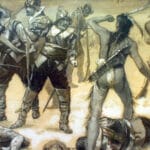Delaware’s First State National Historical Park isn’t just a collection of historic sites; it’s a portal to the past, offering an immersive experience into the birth of a nation. From colonial settlements to pivotal moments in American history, the park tells a rich story of Delaware’s crucial role in shaping the United States. Are you ready to step back in time and explore this historical treasure?
Unveiling Delaware’s Significance: More Than Just the “First State”
The park’s mission transcends simply preserving relics; it’s about conveying the vital role Delaware played in the country’s founding. Delaware earned its nickname, “The First State,” by being the first to ratify the U.S. Constitution on December 7, 1787. But the state’s significance goes far beyond that single act. It was a stage for conflicts between European powers vying for control of the Delaware Valley, a region that fostered a spirit of independence and tolerance.
- Early Settlement: Explore sites that showcase the early Dutch, Swedish, and English settlements in the Delaware Valley.
- Independence: Discover how Delawareans broke ties with Pennsylvania and Great Britain to declare their own state.
- Constitutional Ratification: Stand on the ground where Delaware solidified its place in history by becoming the first state to ratify the Constitution.
Seven Locations, Countless Stories: Exploring the Park’s Units
Unlike many traditional national parks, the First State National Historical Park is comprised of seven distinct locations scattered throughout Delaware. Each site offers a unique perspective on the state’s history, from the mature forests of the north to the coastal charm of Lewes. Here’s a glimpse into what each location offers:
- The Woodlawn Tract at Beaver Valley: Explore the natural beauty of the Brandywine River Valley, where Native Americans and early settlers once lived. This area showcases land preservation efforts dating back to the early 20th century.
- Fort Christina: Discover the site of the first Swedish settlement in North America, marking the beginning of European colonization in the Delaware Valley.
- John Dickinson Plantation: Step back into the 18th century at the home of John Dickinson, a Founding Father and “penman of the Revolution,” whose writings inspired colonial opposition to British rule.
- New Castle Court House Museum: Visit one of the oldest surviving courthouses in the nation, where abolitionists faced trial and Delaware declared its independence.
- Old Sweedes Historic Site: Explore the legacy of Swedish settlers at this historic church and burial ground.
- Ryves Holt House: See what’s believed to be the oldest house in Delaware, dating back to 1665, offering a glimpse into early colonial life.
- The Green, Dover: Visit the historic public square in Delaware’s capital city, where the state voted to ratify the U.S. Constitution.
Planning Your Adventure: A Practical Guide to Exploring the Park
Navigating a national park with multiple locations requires a bit of planning. Here’s what you need to know to make the most of your visit:
- Location & Transportation: Given the dispersed nature of the park, a car is the most convenient way to travel between sites. Consider planning your route in advance, taking into account travel times between locations.
- Hours of Operation: Check the official National Park Service website (https://www.nps.gov/frst/index.htm) for the most up-to-date information on opening hours, as they vary by location and season.
- Accessibility: Accessibility varies from site to site. Check the park’s website or contact individual locations directly to inquire about specific accessibility needs.
- Amenities: Restrooms, visitor centers, and other amenities also vary. Some sites have limited facilities, so it’s a good idea to pack snacks and water, especially if you’re planning on spending a significant amount of time outdoors.
- Guided Tours & Programs: Take advantage of ranger-led tours and interpretive programs offered at various locations. These programs provide valuable insights into the history and significance of the park. Check the park’s website for schedules and availability.
Engaging with History: Activities and Experiences
The First State National Historical Park offers a variety of ways to engage with history, making it an enriching experience for visitors of all ages.
- Guided Tours: Join a ranger-led tour to learn about the history and significance of each site.
- Interactive Exhibits: Explore exhibits that bring the past to life through artifacts, displays, and multimedia presentations.
- Living History Demonstrations: Witness historical reenactments that offer a glimpse into colonial life.
- Junior Ranger Program: Kids can participate in the Junior Ranger program, completing activities to earn a special badge and learn about the park’s history and natural resources.
- Hiking Trails: Explore the natural beauty of the park on its scenic hiking trails.
Beyond the Park: Exploring Delaware
Extend your historical journey by exploring other attractions in Delaware. Visit the charming towns of New Castle and Lewes, explore the state’s beautiful beaches, or delve into the history of the DuPont family at the Hagley Museum and Library.
Family-Friendly Fun: Making History Engaging for All Ages
Planning a family trip to the First State National Historical Park requires a bit of strategy, but the rewards are well worth the effort. Here are some tips for making history fun and engaging for kids:
- Involve Kids in the Planning: Let children help choose which sites to visit based on their interests.
- Turn it into a Scavenger Hunt: Create a scavenger hunt with clues related to the park’s history and landmarks.
- Pack a History-Themed Picnic: Enjoy a picnic lunch at one of the park’s scenic locations while discussing the history you’ve learned.
- Read Books About Delaware History: Before your trip, read age-appropriate books about Delaware’s history to get kids excited about what they’ll see.
- Ask Questions: Encourage children to ask questions and engage in discussions about the park’s history.
A Lasting Legacy: Preserving the Past for Future Generations
The First State National Historical Park stands as a testament to Delaware’s rich history and its pivotal role in shaping the United States. By preserving these historical sites and sharing their stories, the park ensures that future generations will have the opportunity to connect with the past and understand the foundations of American identity. It’s more than just a park; it’s a living classroom, a place of reflection, and a reminder of the values that have shaped our nation.
- Unveiling the Enigma: Mansoureh Khojasteh Bagherzadeh’s Public Appearances & Private Life in Iran - July 18, 2025
- Unveiling the Mystery: Mansoureh Khojasteh Bagherzadeh’s Husband: A Rare Glimpse into a Private Life - July 18, 2025
- Unveiling Masoud Khamenei’s Mother: Power, Influence, and Iran’s Future - July 18, 2025
















